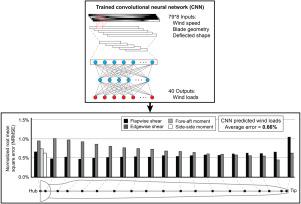Journal of Wind Engineering and Industrial Aerodynamics ( IF 4.2 ) Pub Date : 2021-07-03 , DOI: 10.1016/j.jweia.2021.104696 Eric Rowland Lalonde 1, 2 , Benjamin Vischschraper 1 , Girma Bitsuamlak 1 , Kaoshan Dai 3

|
Current numerical aerodynamic wind turbine blade models – models that calculate the aerodynamic loads on a blade based on the incoming wind – are generally computationally intensive. However, a surrogate aerodynamic blade model consisting of a neural network (NN) trained on high-accuracy data should be capable of achieving both high accuracy and fast computation times. In this study, six different NNs were trained using numerical data from aeroelastic blade simulations, then compared for the highest possible prediction accuracy while maintaining high speeds. The NNs include two time-independent multilayer perceptron (MLP) networks with a full and reduced set of input data. A time-dependent long short-term memory (LSTM) network was also trained, along with a similar Pseudo-time-dependent MLP. Finally, a time-dependent convolutional neural network (CNN) and a similar Multi-time-step MLP were trained and compared. Over 30 million data points of aeroelastic time history information of an operational 5MW wind turbine across 115 time histories and 23 different mean wind speeds were numerically generated for training the networks. The architecture, input and output data, and the optimization and training processes are provided in detail for each network, and the resulting accuracy and computation times are analyzed and compared. Ultimately, it was found that both the trained full-input MLP and the CNN were particularly accurate surrogate models, with average normalized root mean square errors of 1.11% and 0.66% respectively. While the CNN surpasses the full-input MLP in accuracy, the latter is simpler to train and faster to run, thus both are compelling options for future researchers. Such a surrogate model could be used to predict the aerodynamic loads on a wind turbine blade when computation speed is a priority, such as during design optimization or hybrid simulations.
中文翻译:

用于生成替代气动风力涡轮机叶片模型的神经网络类型和架构的比较
当前的数值气动风力涡轮机叶片模型——根据来风计算叶片上的气动载荷的模型——通常计算量很大。然而,由在高精度数据上训练的神经网络 (NN) 组成的替代气动叶片模型应该能够实现高精度和快速计算。在这项研究中,使用来自气动弹性叶片模拟的数值数据训练了六个不同的神经网络,然后在保持高速的同时比较可能的最高预测精度。NN 包括两个时间无关的多层感知器 (MLP) 网络,具有完整的和简化的输入数据集。还训练了时间相关的长短期记忆 (LSTM) 网络以及类似的伪时间相关 MLP。最后,训练并比较了时间相关的卷积神经网络 (CNN) 和类似的多时间步长 MLP。超过 3000 万个运行中的 5MW 风力涡轮机的气动弹性时间历史信息数据点跨越 115 个时间历史和 23 个不同的平均风速,以数值方式生成用于训练网络。详细提供了每个网络的架构、输入和输出数据以及优化和训练过程,并分析和比较了由此产生的准确性和计算时间。最终发现,经过训练的全输入 MLP 和 CNN 都是特别准确的代理模型,平均归一化均方根误差分别为 1.11% 和 0.66%。虽然 CNN 在准确度上超过了全输入 MLP,但后者训练更简单,运行速度更快,因此,对于未来的研究人员来说,两者都是令人信服的选择。当计算速度优先时,例如在设计优化或混合模拟期间,这种替代模型可用于预测风力涡轮机叶片上的空气动力载荷。











































 京公网安备 11010802027423号
京公网安备 11010802027423号